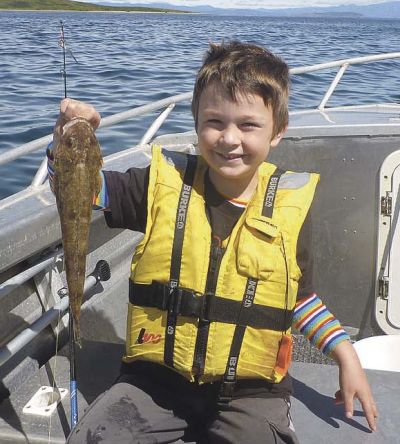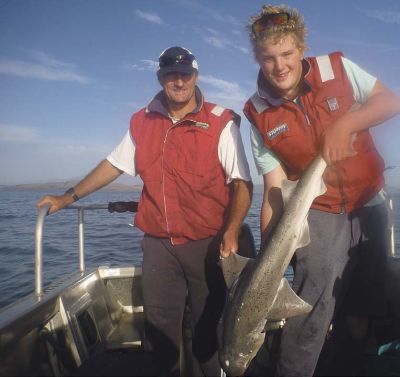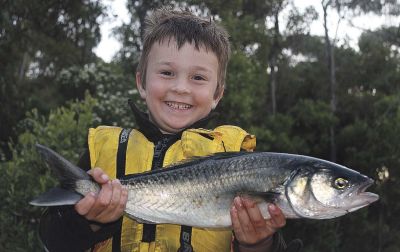 Presented from Issue 112, October 2014
Presented from Issue 112, October 2014
The warmer part of spring is now upon us and for the saltwater angler, this signals the start of some fine fishing days ahead. Here, Matt Byrne outlines some of his very best spring saltwater options.
I’m not too sure about you, but as a keen saltwater angler, winter in Tasmania can be a long and drawn out affair as the saltwater cools down and species disappear to the depths or in some cases, leave the state entirely and follow the currents in search of warmer water! Whilst this past winter we have had an unusually long southern bluefin tuna season, more often than not we spend our time doing jobs around the house and await October as it often signals the first real commencement of our saltwater fishing season.
Whilst we might not have the consistently have the year round hot saltwater action that other mainland states can offer, this situation changes quite rapidly in Tasmania as we hit mid spring and all of our staple saltwater species re-enter the shallower bays and start to feed without hesitation.
We are talking sand and tiger flathead, Australian salmon, calamari and arrow squid, sharks, whiting to mention just a few. I regard the keys to success at this time of year to be careful choice of location and some attention to detail with your tackle, bait and lure selection. We now examine each of those aspects in further detail.
 |
| Small sharks are not uncommon. |
Locations and Tips
The first question you really need to ask yourself is - what is my target species going to be? For many, sand flathead and tiger flathead will be the primary target due to their fine eating qualities. It so happens to be though, that many of the locations that are prime flathead spots, also offer a variety of other species if you know where to look.
The great thing about Tasmania is that whether you live in Hobart or Launceston, we are never too far away from some quality fishing spring saltwater fishing. The below locations have been chosen for the particular reason that they are expected to be hot options this spring as well as being accessible to the major population centres:
Bicheno
Bicheno on the East Coast could well be one of Tasmania’s most underrated spring saltwater locations. The commonly used boat launching ramp is located at the township near the ‘Gulch’ and this places you pretty much central to the Bicheno fishing grounds. I must admit that it can take some time to learn the habits of fishing Bicheno and its various fish holding areas, so hopefully I can narrow that search just a little for you here. Bicheno tends to have a more of a ‘reefy’ bottom structure and as such if your target is sand and tiger flathead, then you will need to be absolutely on the money in where you choose to fish. There is good sandy bottom in around and north of Diamond Island that will put you onto good flathead, however by far my favourite spot where flathead can be found in reliable numbers is the area heading south from the ‘Gulch’ down into Courland Bay and Friendly Beaches. There is an excellent and consistent sandy bottom down in this area where you will find a lot of good fish at the 20 to 30 metre mark.
Elsewhere, at Bicheno, fishing the more reefy bottom as commonly found straight out from the ‘Gulch’ and down to Cape Lodi and concentrating in water 50 metres plus, you will find good numbers of silver morwong. These fish generally have a very good size to them, with a lot of fish around the 1 – 1.5 kg bracket and they present a good fight on the right tackle.
Bicheno also offers a good run of very large calamari squid and these can be successfully targeted for shore based anglers off the Breakwall near the tavern or by boat anglers fishing close inshore late afternoon towards dusk from Waubs Bay around to the Gulch.
Great Oyster Bay
Great Oyster Bay also on the East Coast is a real favourite due to its accessibility from a number of seaside towns with boat launching ramps at Coles Bay, Swansea and Little Swanport.
Great Oyster Bay by nature has an expansive sand bottom which makes it perfect for setting up a drift and finding fish. I have found from previous experience that whilst flathead can be found anywhere from inshore out to some miles from shore, you do often need to be prepared to move around and find the correct depth of water where fish are concentrated. 15 – 30 metres often is the most reliable gauge to work from and I find myself regularly heading more so to the deeper 30 metre mark early on in Spring.
If you have spent a few hours fishing the fish rich open waters of Great Oyster Bay and you now have a feed of quality flathead, you may be looking for a change of style of fishing and a few more species to add to the list.
Swan River
The Swan River is fed by Great Oyster Bay and is an amazing and diverse fishery with great accessibility via a couple of boat launching ramps off Dolphin Sands Road (One ramp situated mid river and the other ramp near the river mouth).
Here the fishing takes on a completely different form as southern black bream, leatherjacket, Australian salmon and sometimes Tailor can be on the list. The Swan River can accommodate both the lure and bait angler. Lure fishing for bream is popular in the slower flowing mid to upper reaches, whilst the lower part of the estuary out to the river mouth offers a greater scope for the bait angler who can make very good use of timing their fishing around the change of the tide, as well as fishing the points and little bays that this part of the Swan River has to offer.
Perhaps one of the biggest drawcard’s in fishing the mouth of the Swan River at this point in the year is the amazing runs of large Australian salmon that enter this part of the river. Fish up to 2kg are available sometimes in huge numbers and you will struggle to find a more entertaining form of fishing for these highly mobile sportfish in quite deep and heavy flowing current.
 |
| Flathead are a reall favourite! |
Cremorne
For southern based anglers, a location that is literally on the doorstep is Cremorne. Here within 30 minutes of home, a boat can be launched into the Cremorne Canal near Pipeclay Lagoon and depending on weather, a short run out of the canal gives anglers access to a huge expanse of great fishing water including Frederick Henry Bay, Slopen Island, Saltwater River and Betsey Island.
The waters of Frederick Henry Bay across to Slopen Island and Saltwater River can really turn on some good flathead fishing. Whilst having a bit of a reputation for occasions where a lot of undersize fish can be present and cause frustration, again you have to move around and find the larger fish and they are there (some of the largest flathead I have seen have come from this location). To point anglers in the right direction though, you are best to increase your fishing efforts closer to the Slopen Island/Saltwater River side of the bay as there is a slight increase in depth and although the whole area is rarely deeper than 20 metres, you will often find quite a difference in your catch rates on flathead if fishing that maximum 20 metre depth as opposed to the shallower 12-15 metre depth range. Whilst fishing, observe your sounder closely and take note of the depth where you are finding fish and work according to that.
As you drift the above regions, do not be at all surprised by the level of shark by- catch in the form of large gummy shark and broadnose shark (or ‘sevengillers’). I call them by-catch as Frederick Henry Bay is a shark refuge area and as such a ‘no take’ zone for sharks and any caught should be returned to the water immediately unharmed. Some days, your flathead baits will be taken readily by the above species presenting somewhat of a nuisance but at the same time, some ‘action’ on board in not knowing just what has been hooked! Get them in quickly, remove the hook and let them go. Their sheer numbers are present for a reason and certainly highlight the benefit of shark refuge areas in the sustainable management of shark species.
Depending on the season, the Cremorne to Slopen Island area can be a very good place for calamari and arrow squid. Arrow squid have a tendency to be found just about anywhere and everywhere and location is generally not too important, however there are some good calamari holding spots near Slopen Island in the shallower water. Look for anywhere there happens to be sea grass and concentrate your efforts there. A tasty calamari squid shouldn’t be too far away.
Another species that this region is well known for is the humble sand whiting and whilst not up on the list of desirable species for many anglers, they can bite continuously and can be great fun for the kids. You will encounter this species quite close inshore and short run out from Cremorne will put you right amongst these fish.
Gear, Bait and Lure Selection
When it comes to specific gear that you will need for targeting the full suite of spring saltwater options, you need not get too complicated about it. Quite simply, you will need to be armed with two specific set ups – one for your heavier duty bottom fishing, and one for targeting your smaller midwater species.
Firstly, a good sturdy bottom fishing rod (but sensitive in the tip section) in the 5-10kg bracket, matched with a quality Shimano, Diawa, Penn or Finn Nor 5000- 6000 size reel (or small Overhead style reel if you prefer) and a quality 20lb braid (in 6lb diameter) such as Finns is all that you require. This will handle all of your bottom fishing applications with ease, yet importantly enable you to fish with more than enough sensitivity to detect bites.
Your second set up is a slightly lighter spinning rod in the 3-4kg bracket with a quality threadline in the 2000-4000 size range (the above reel brands are again, hard to go past for value and reliability) and a 6-8lb braid again in either Finns, or even Fireline is a great choice. This set up enables effective presentation of smaller lures, hooks and baits again whilst being able to detect subtle bites.
For the heavier duty bottom bashing on species like Flathead and Silver Morwong, all you will require is a handful of two hook paternoster rigs and a good selection of sizes of ‘clip on’ Snapper style sinkers. A range of sinker sizes will enable you to adjust your bottom holding capacity around the speed of the drift, depth and current. When it comes to hooks, I find it hard to go past chemically sharpened circle hooks in the 2/0 – 4/0 sizes as they have not only amazing bait holding potential but also an excellent hook up rate and it is indeed rare for one of these hooks to fall out of a fishes mouth midway through the fight.
When it comes to bait and lure selection for the above style of fishing, I like both! Bait fishing for species like Flathead will always go hand in hand and for that reason, prime baits like Squid strips and tentacles as well as strip baits of oily fish like Australian Salmon and Mullet will always have a place on my boat as they work! That said, there are a simply an amazing range of soft plastic lures on the market particularly from Berkley in the ‘Gulp’ range that the Flathead and even species like Silver Morwong cannot resist. Try the very natural Berkley 2 inch ‘Crabby’ range as well as the larger 3-4 inch Berkley Gulp Minnows in Red Green Sparkle, Choc Sparkle or Glitter Pink. You need only fish these plastics on a 2/0 jig head and present them on the top dropper of your paternoster rig for best results.
As for the host of other spring saltwater species like Australian Salmon, Bream, Leatherjacket, Whiting and Squid, other than the latter three species there really is no hard or fast rule on choice of bait vs lure and it is more about personal choice and your own fishing satisfaction.
For me, fishing for Australian Salmon on a light 3kg outfit is all about fishing hardbody and soft plastic lures. The gusto that this species attacks a lure and the ensuing fight commonly from fish in the 1-2kg range sees them perfectly suited to this form of fishing and as such 20-30 gram Halco silver slices or a 3 inch Berkley minnow in Pearl Watermelon or Watermelon Smelt fished on a 1/0 jig head are really all you will ever need if targeting this species. I have also had very good success using any of the silver/blue/green combinations in the Tassie Devil range but be sure to replace the treble with a size 1 – 1/0 single hook for a better conversion on hooked fish as they do have a tendency to ‘throw’ a treble fairly easily. On the other hand, should you choose to target Australian Salmon with bait, pilchards or Squid tentacles are hard to beat and fished on a 1/0 – 2/0 hook either via a running sinker rig or paternoster set up.
If fishing the estuary waters like the Swan River, species such as Bream can be successfully targeted using both bait and lure. The common denominator with Bream whichever way you go is that they require a degree of finesse when it comes to presentation. If targeting Bream with bait, wherever possible use fresh bait such as fresh shrimp, prettyfish, sandworms or crabs presented on a light chemically sharpened size 6 hook.
Wherever possible use an unweighted bait presentation as this will more likely be more freely accepted by Bream, as opposed to a weighted presentation.
If you do however need to battle some wind or current and a sinker becomes a must, use the lightest possible ball sinker required and rig this using a running sinker set up to avoid Bream picking up any unnatural weight, that if not achieved will result in them dropping the bait. Should your choice be lures on this species, then it is hard to go past soft plastics that match the food items of this species with amazing resemblance. Here we are talking plastics such as Berkley sandworms in natural and camo colours, Squidgy wrigglers in avocado and 2 inch Crabby in green camo. Choice of jig head will mostly vary from 1/12 – 1/16 weight wise, and a number 1 hook size will cover most applications.
Leatherjacket and Whiting are almost exclusively a bait presentation option. Small 6-8 size hooks and in the case of leatherjacket, unweighted bait presentation is best. Accordingly small baits such as pieces of squid, fish and frozen prawns will readily be taken. In the case of whiting, while the small hook applies, weighted presentation on your standard flathead paternoster rig is perfect for them and they are simply a great fish to entertain the kids with.
Last but by no means least, calamari and arrow squid are great fun to catch on your light 3-4kg spinning outfit. Whilst arrow squid are voracious feeders and will literally attack any squid jig in sight, calamari squid on the other hand can at times be much fussier. As such, you will are best to carry a range of jig sizes and colours. The red and white Yo Zuri jig is a proven style and colour and having a few of these in your tacklebox is a must. Other colours that seem to work consistently well are purple, blue and bright orange. I found purple jigs to catch very well last season, so it does pay to experiment if you find you are receiving little interest when using certain jigs.
 |
| Australian Salmon - Another favourite |
Catch of the Day
Now that you have a feed of spring saltwater fish, It would be quite an injustice not complete this article without at least one recipe. While most of us commonly enjoy our fish in an array of special batters, fish parcels, curries and mostly have our favourite recipes well and truly down pat, I have a favourite but simple flathead recipe that I would like to share with you.
First, lightly pan fry your flathead (but can substitute using other similar textured fish) in a coating of your choice, I like either a mix of flour/curry powder, egg and bread crumbs or just a simple packet fish coating mix. Next lay your cooked fish on a soft taco wrap and add grated lettuce, grated carrot, grated cheese, diced fresh tomato and diced mango (optional). Finish off with a small scoop of sour cream and a splash of sweet chilli sauce and then rewrap and enjoy! I have found this to be a refreshing way to enjoy fish (especially on warmer days) and a slightly healthier option free of the more ‘oilier’ or greasy deep fried options. There is no easier and tastier recipe, try it as I’m sure you too will enjoy!
So there you have it, a few locations and tips on hitting the salt this spring. We sure have some great saltwater fishing ahead of us, so get out there and enjoy it!
Matt Byrne.




